Devil’s Canyon Review: Intel Core i7-4790K and i5-4690K
by Ian Cutress on July 11, 2014 10:00 AM EST- Posted in
- CPUs
- Intel
- Haswell
- i7
- Overclocking
- Devil's Canyon
- i5
- 4790K
- 4690K
CPU Benchmarks
The dynamics of CPU Turbo modes, both Intel and AMD, can cause concern during environments with a variable threaded workload. There is also an added issue of the motherboard remaining consistent, depending on how the motherboard manufacturer wants to add in their own boosting technologies over the ones that Intel would prefer they used. In order to remain consistent, we implement a OS-level unique high performance mode on all the CPUs we test which should override any motherboard manufacturer performance mode.
HandBrake, SD Film: link
For HandBrake, we take two videos (a 2h20 640x266 DVD rip and a 10min double UHD 3840x4320 animation short) and convert them to x264 format in an MP4 container. Results are given in terms of the frames per second processed, and HandBrake uses as many threads as possible.
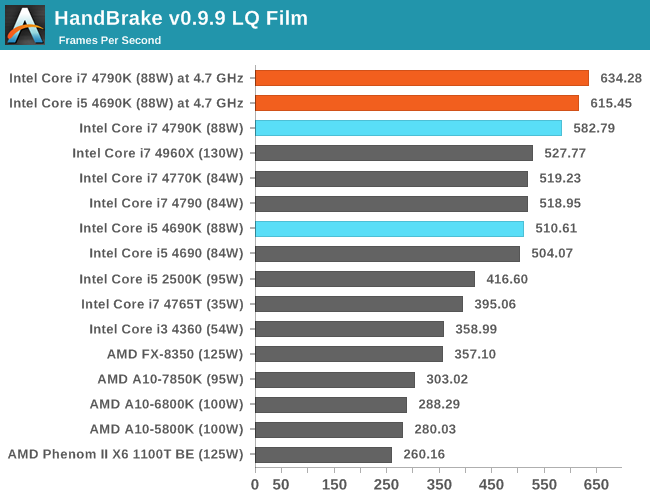
HandBrake, 4K60 Animation: link
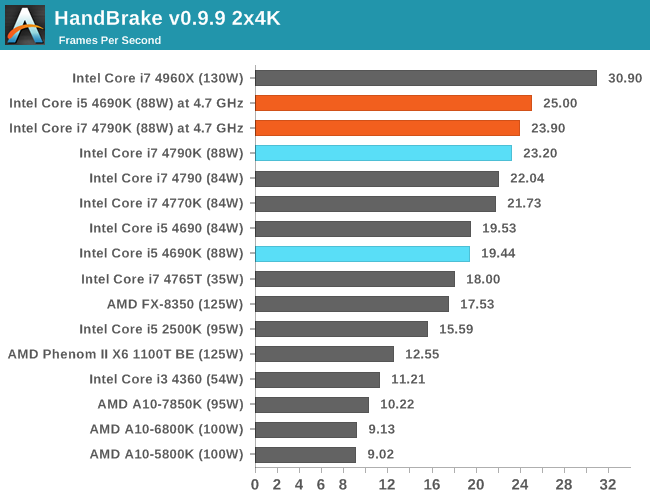
Agisoft Photoscan – 2D to 3D Image Manipulation: link
Agisoft Photoscan creates 3D models from 2D images, a process which is very computationally expensive. The algorithm is split into four distinct phases, and different phases of the model reconstruction require either fast memory, fast IPC, more cores, or even OpenCL compute devices to hand. Agisoft supplied us with a special version of the software to script the process, where we take 50 images of a stately home and convert it into a medium quality model. This benchmark typically takes around 15-20 minutes on a high end PC on the CPU alone, with GPUs reducing the time.
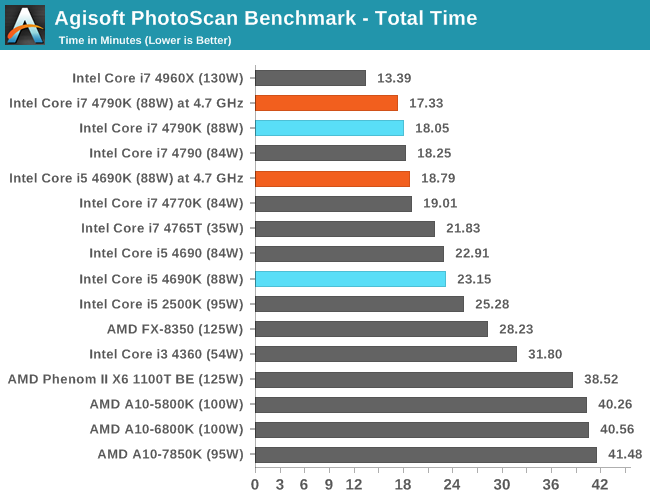
Dolphin Benchmark: link
Many emulators are often bound by single thread CPU performance, and general reports tended to suggest that Haswell provided a significant boost to emulator performance. This benchmark runs a Wii program that raytraces a complex 3D scene inside the Dolphin Wii emulator. Performance on this benchmark is a good proxy of the speed of Dolphin CPU emulation, which is an intensive single core task using most aspects of a CPU. Results are given in minutes, where the Wii itself scores 17.53 minutes.
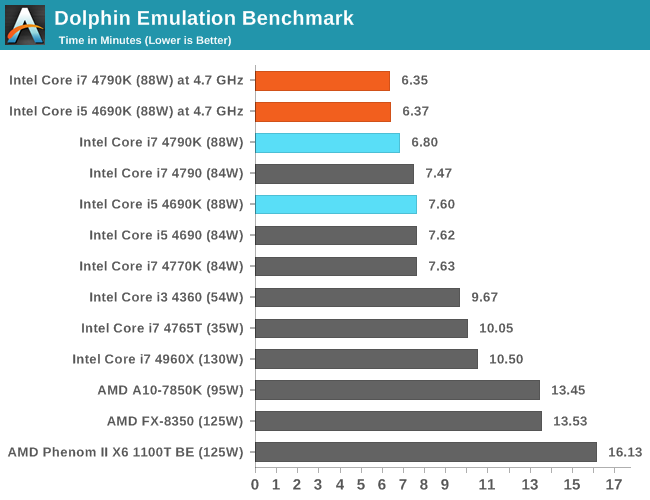
WinRAR 5.0.1: link
This test compresses a set of 2867 files across 320 folders totaling 1.52 GB in size – 95% of these files are small typical website files, and the rest (90% of the size) are small 30 second 720p videos.
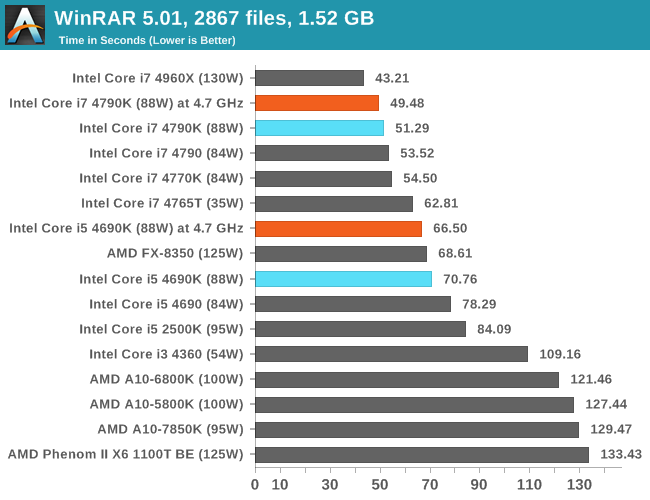
PCMark8 v2 Work 2.0 OpenCL on IGP
A new addition to our CPU testing suite is PCMark8 v2, where we test the Work 2.0 and Creative 3.0 suites in OpenCL mode. As this test is new, we have not run it on many AMD systems yet and will do so as soon as we can.
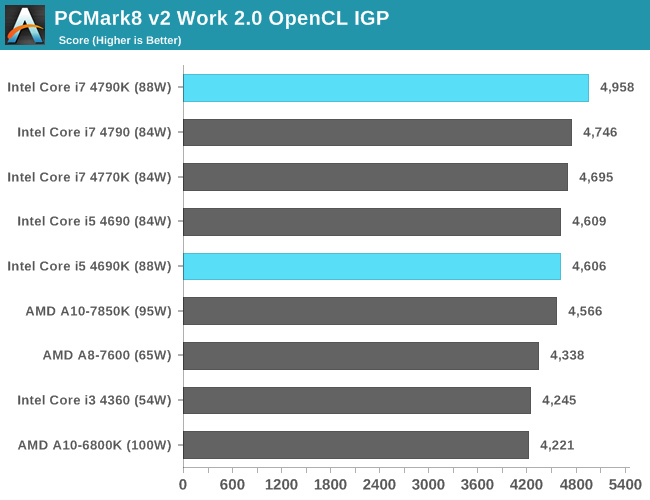
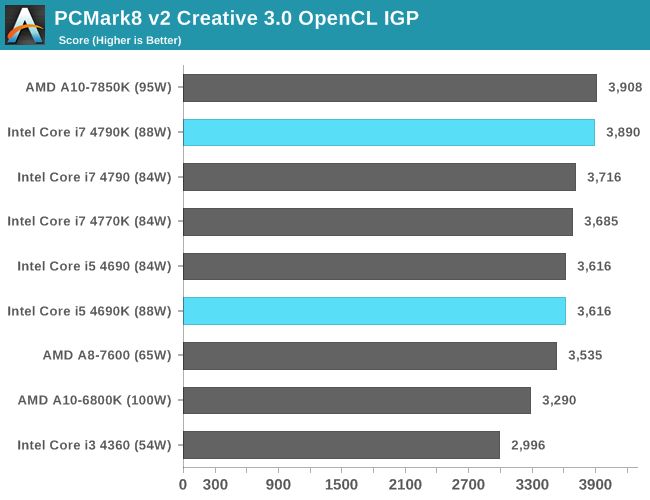
Hybrid x265
Hybrid is a new benchmark, where we take a 4K 1500 frame video and convert it into an x265 format without audio. Results are given in frames per second.
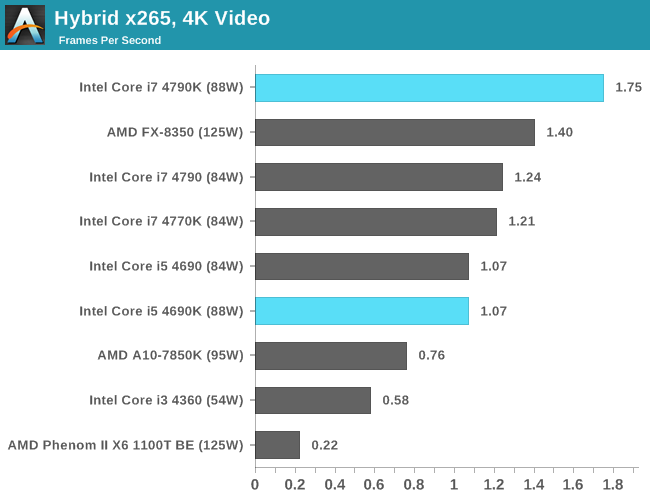
Cinebench R15


3D Particle Movement
3DPM is a self-penned benchmark, taking basic 3D movement algorithms used in Brownian Motion simulations and testing them for speed. High floating point performance, MHz and IPC wins in the single thread version, whereas the multithread version has to handle the threads and loves more cores.
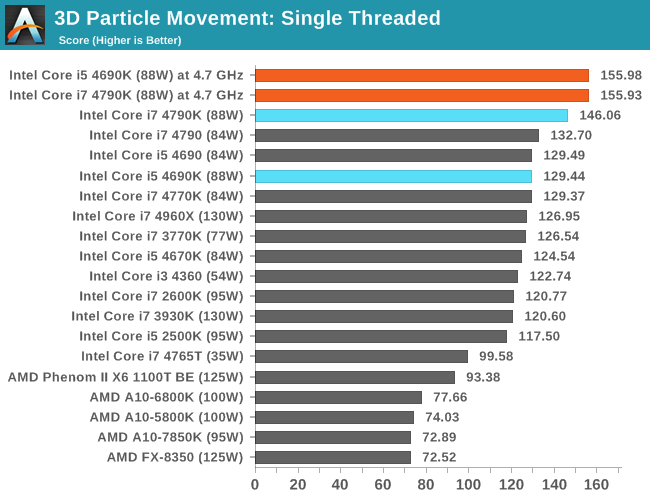
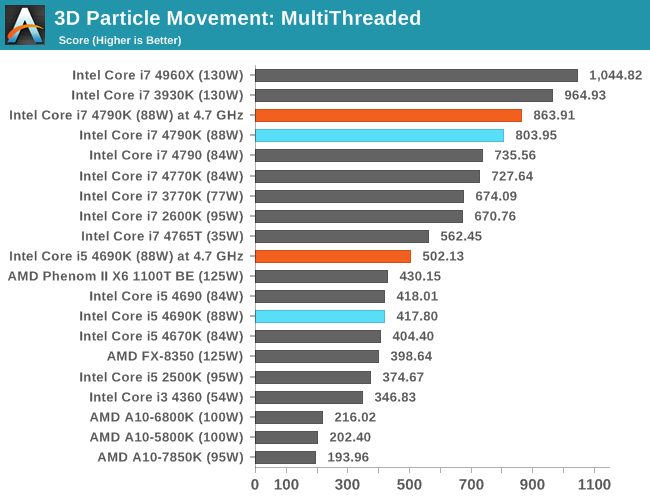
FastStone Image Viewer 4.9
FastStone is the program I use to perform quick or bulk actions on images, such as resizing, adjusting for color and cropping. In our test we take a series of 170 images in various sizes and formats and convert them all into 640x480 .gif files, maintaining the aspect ratio. FastStone does not use multithreading for this test, and results are given in seconds.
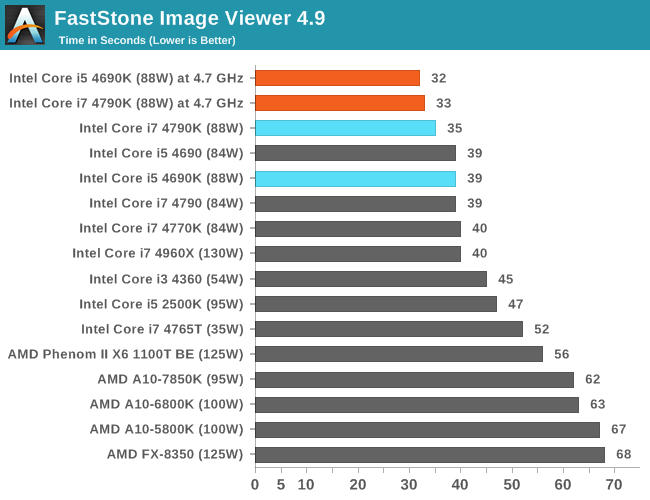
All of our CPU benchmarks are responsive to more frequency, and for tests that are all about single threaded performance (3DPM-ST, FastStone, Dolphin), the overclocked processors match each other. The highly clocked i7-4790K at stock is taking the lead in each of these benchmarks against the other processors at stock frequencies quite easily. For multi-threaded scenarios, it is interesting to note that when overclocked, Handbrake does not seem to use the extra threads that efficiently when encoding 4K60. This is presumably because each thread needs a fair amount of cache and there is little speed-up in switching the work between threads.










117 Comments
View All Comments
vastac13 - Friday, July 11, 2014 - link
Just when I'm about to go to bed... Good thing I checked 1 more time :D Happy reading folks!Iketh - Friday, July 11, 2014 - link
I just hope Intel has another massive breakthrough in performance soon because rendering a 4K mp4 is gonna SUCKDon't need AMD for this case, the industry will drive it this time...
ddriver - Friday, July 11, 2014 - link
Looks like desktop CPU performance is hitting a brick wall, the last 4 generations are barely incremental in performance. Could very well be the product of AMD ultimately failing to compete in the high end. I don't complain, this way I don't feel the urge to upgrade my 3770k.Antronman - Thursday, July 17, 2014 - link
IBM says silicon will end up limiting CPU capability, and are investigating alternatives.jhawkinstx - Tuesday, March 3, 2015 - link
Yes, when I heard that in the news I went out and invested in companies with alternative tech (Gallium-Arsinide based processors) which did not have the limitations of silicon.......that was in the late 1990s....seems the end of silicon, like peak oil, has been preached for quite some time. For now, I will just wait patiently with my 4 year old Intel boxes. When something more than incremental improvement arrives I will buy.Chaser - Monday, December 29, 2014 - link
Nor do I with my 2600K. It would be throwing money away. I am a single monitor 2440P higher end gamer that does some office work as well. I have no CPU shortfalls.jhawkinstx - Tuesday, March 3, 2015 - link
I agree, I have 4-intel 2600K boxes and which run my business jobs at roughly the same rate as the Xeon based box I bought a year earlier, but with the 2600K costing 1/6 the price of the xeon. Current benchmarks show me nothing worth spending the money on. If anything I would add another 2600K box for roughly $200/processor.JlHADJOE - Saturday, March 21, 2015 - link
On the contrary, CPU performance has been steadily increasing, but Intel has been choosing to spend those IPC gains on lowering the TDP instead of increasing outright performance.wrkingclass_hero - Sunday, July 13, 2014 - link
It's funny, I'm actually rendering a 4K mp4 right now! My 4.6 GHz 3930k looks like it's going to take a grand total of 21 hours to render it... and it's a 3 minute clip...But there are a lot of effects on it (stabilization, layers of videos, etc.) It also doesn't help that it is a two pass.
ddriver - Monday, July 14, 2014 - link
What do you expect, throwing such a workload on a measly single cpu - such tasks are performed by rendering farms with thousands of quad socket machines.